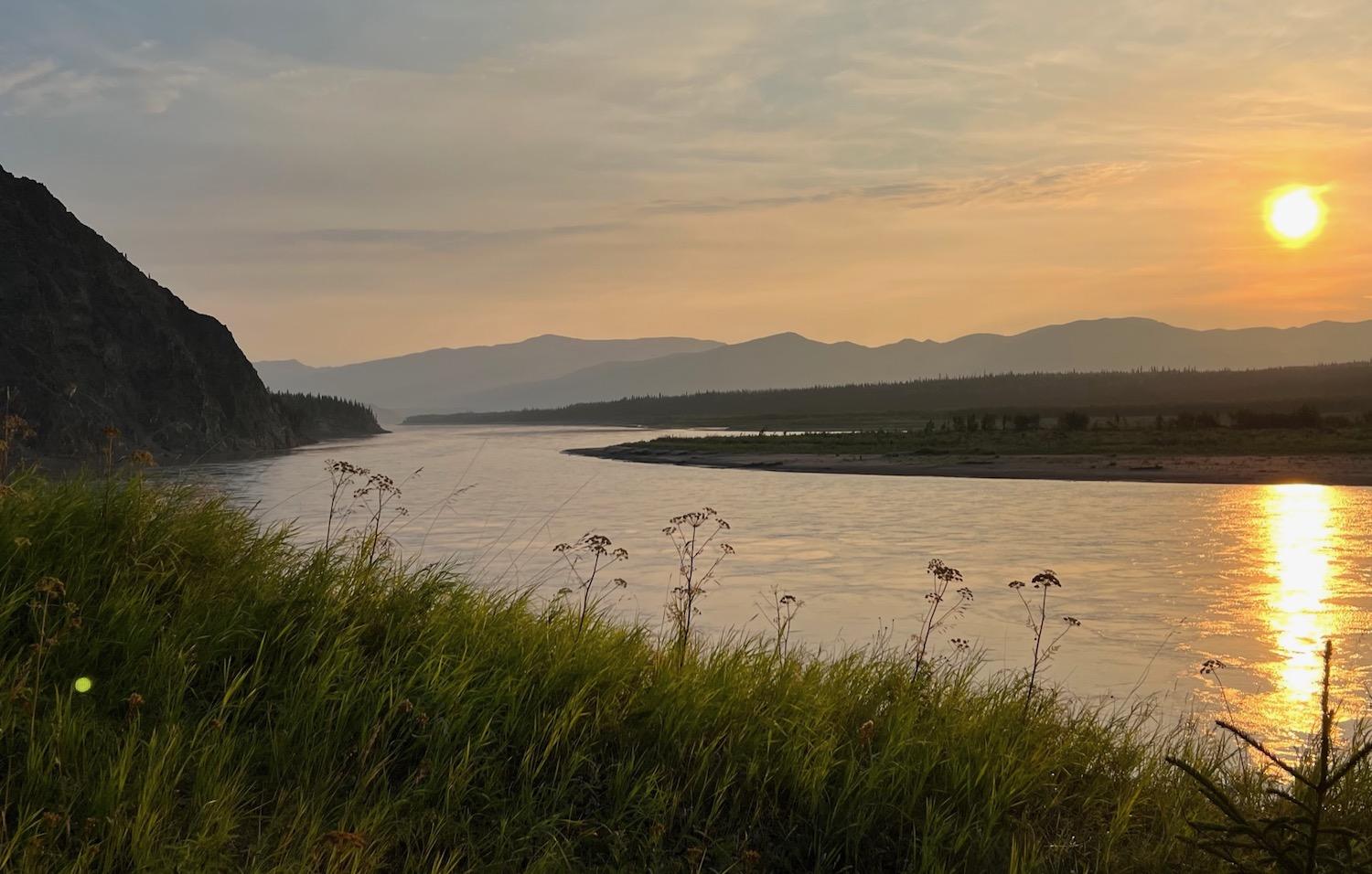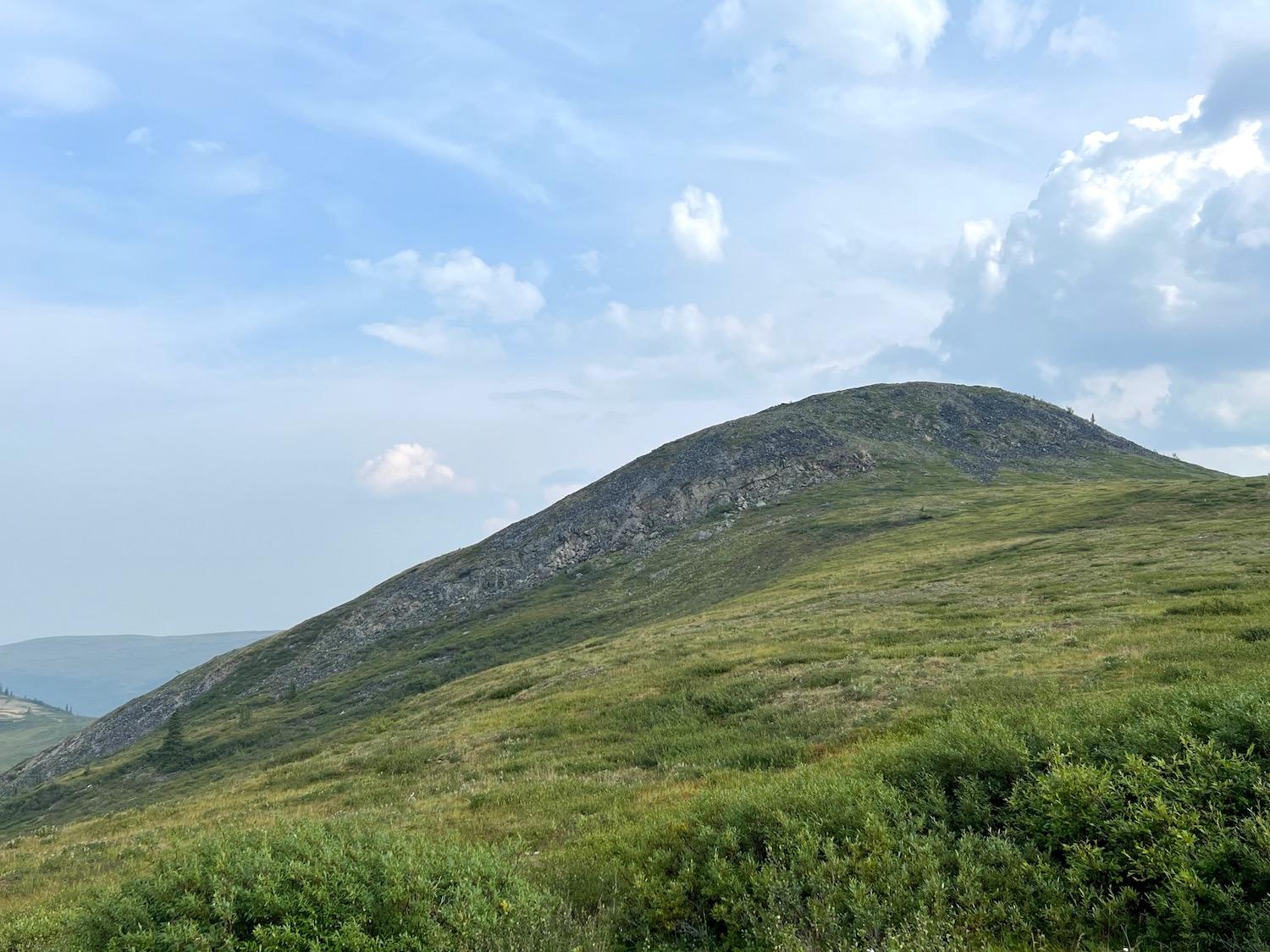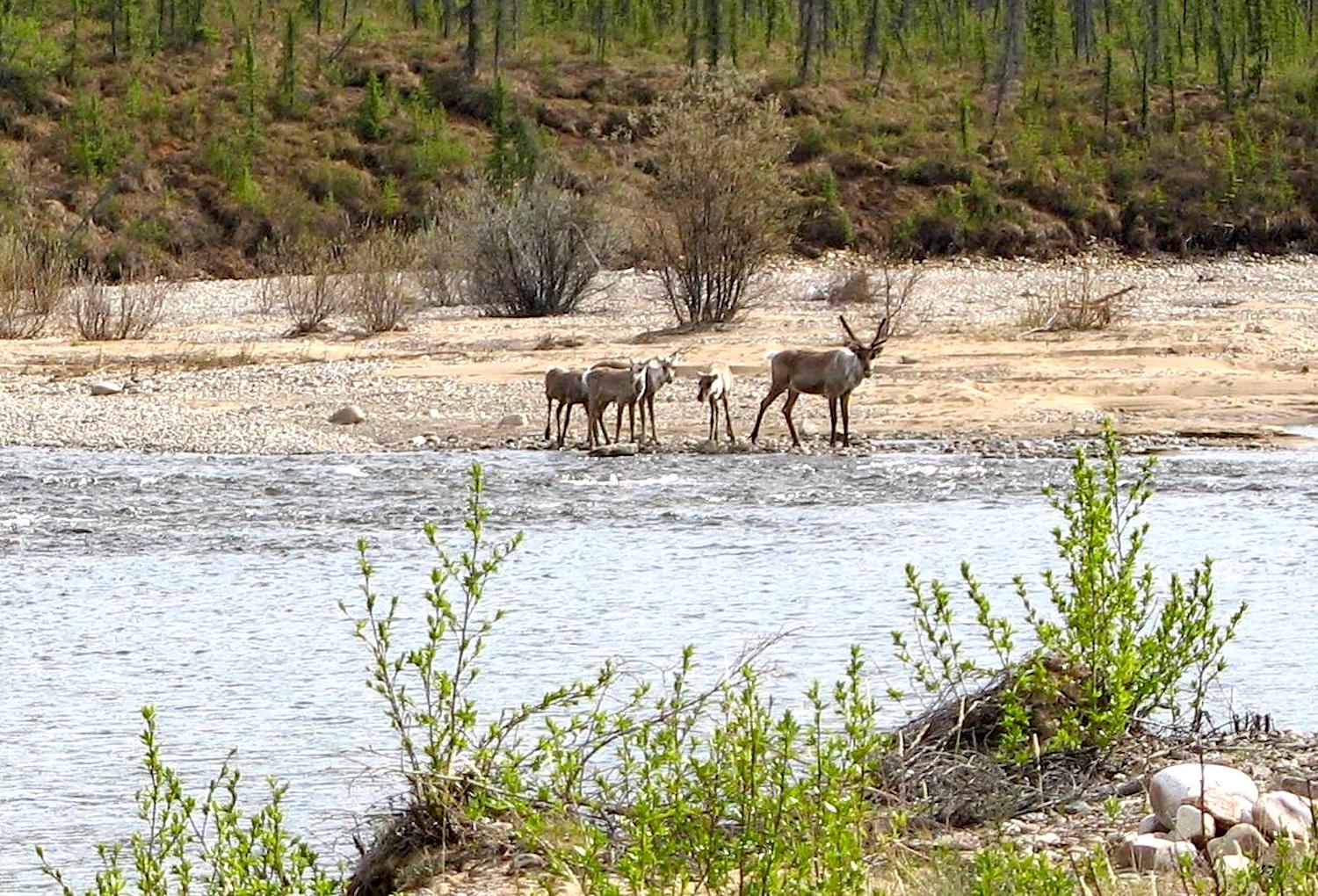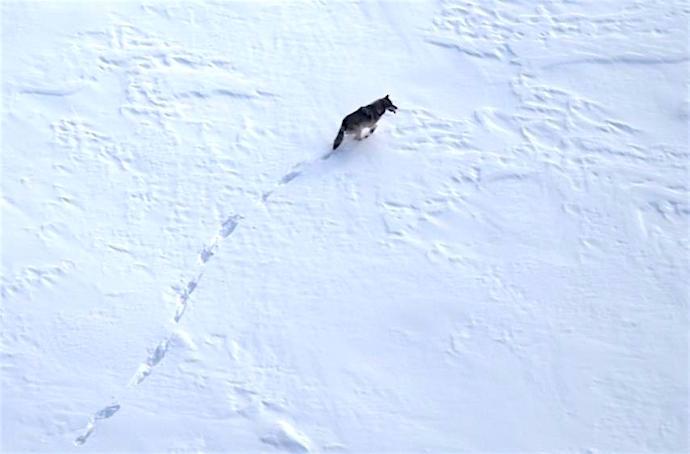
A stretch of the Yukon River flows through Yukon-Charley Rivers National Preserve/Barbara Jensen
Searching For The Wolves Of Yukon-Charley Rivers National Preserve
By Barbara 'Bo' Jensen
I turn the Jeep north at Tetlin Junction onto Alaska’s Taylor Highway. I’ve been told this area from Tok to Eagle is wolf country. “But you probably won’t see any wolves,” people cautioned. “They’ll be deeper into the preserve.” I’m trying to remain realistic, pragmatic. Even so, I’ve crossed the Tanana River, hoping to find them anyway. I’m heading to Eagle. I want to know what’s happening with the wolves of Yukon-Charley Rivers National Preserve.
The 2.5-million-acre preserve encompasses a roughly 120-mile stretch of the nearly 2,000-mile-long Yukon River that streams east-west across Alaska; the 106-mile Charley River that flows into it; and, the Charley’s entire 1.1-million-acre watershed. Among the National Park Service's responsibilities here, as laid out by Section 201 of the Alaska National Interest Lands Conservation Act, is to "protect habitat for, and populations of, fish and wildlife, including but not limited to the peregrine falcons and other raptorial birds, caribou, moose, Dall’s sheep, grizzly bears, and wolves..." (emphasis added).
I’m traversing the Yukon-Tanana Uplands, a highland plateau of immense foothills north of the massive Wrangell Mountains. This landscape slowly unrolls before me, and I follow the undulating road over hills covered in black spruce, birch, and alder as if I’m paddling a canoe on the water. I had hoped to see the restored Slaven’s Roadhouse, a 1930s two-story landmark a few days’ float down the Yukon from Eagle. But several of the old log structures the preserve offers as riverside public use cabins have been shifted off their foundations by ice jams and flooding at spring break-up. I have had to adjust my expectations and change my strategy.
Before I get to the rivers, however, I have to get past Chicken, one of the few surviving goldrush towns in Alaska (if a population of 12 counts as surviving). To get past Chicken, it’s best to gas up here — and shift into four-wheel drive. This is where the pavement ends. I avoid the deepest holes as gravel washboards try to shake me off the narrow mountain road, barely one lane wide in places. No guardrails protect you from plummeting down the steep slopes.
I pass the turnoff to Boundary. Davis Dome is an impressive alpine landmark at the Canada border, with a sign announcing your entry into the Fortymile Management Area. The Yukon River forms the northern boundary of the Fortymile Caribou Herd’s territory here (named for the area’s branching Fortymile River). The Tanana River creates the southern limit. Caribou prefer these high, wind-blown, lichen-covered slopes I’m driving through. Along the rivers you find willowy moose habitat; I’ve already seen five or six along the way. North of the Yukon, I’ve been told, you find wolves. This whole area feels rich with wildlife, and I’m even more curious to learn how the wolves are faring — because it hasn’t been easy for them here.

Davis Dome/Barbara "Bo" Jensen
After a deep sleep at the immaculate Bureau of Land Management campground on the edge of town, I arrive early the next morning at the Eagle Visitor Center. It’s not open yet. I sit at a picnic table on the park grounds, drinking coffee in the shadow of 1,400-foot Eagle Bluff, watching the sun rise over the mighty Yukon River. While the Charley is a tumultuous “wild and scenic” river, the Yukon is wide, slow, and muddy, laden with glacial silt. It seems manageable enough, I think, until a skiff comes motoring around a bend, appearing as tiny as an ant and immediately shifting my perspective.
“It’s important to understand this place and manage your expectations,” I’d been advised. At Yukon-Charley Rivers, they monitor Dall sheep, moose, and wolves, trying to manage for healthy populations. According to Mat Sorum, the preserve’s wildlife biologist, his recent sheep survey indicates a significant decline in population, and a preserve moose survey last year showed a 35 percent decline over the last six years. But the public, especially hunters and members of the Fortymile herd’s Harvest Management Coalition, seem to be fixated on the instability of the caribou herd outside the preserve.
And they blame the Yukon-Charley Rivers wolves.
It's Complicated
Species and habitat management in Alaska is complex. According to Alaska Fish and Game’s Fortymile Caribou Herd Harvest Plan, “predator management tools” are utilized by the state to increase the herd size. This translates to bear and wolf hunting — by the state. However, federal land managers in Alaska are mandated to protect specific wildlife species within the parks, preserves, and refuges they oversee. The state’s plan for predator control often conflicts with federal conservation plans for those same predator species. In addition, nearly all public lands in Alaska are required by law to support and prioritize rural Alaskans’ personal subsistence uses related to harvesting animals and plants. And in 1990, changes to subsistence oversight created a mismatched dual system of state and federal subsistence guidelines.
Those conflicting approaches stand out when it comes to managing the preserve's wolves. In 2011, the Park Service said Yukon-Charley Rivers was home to at least 71 wolves, divided among nine packs. Wolf density in the preserve was above the 18-year average. In 2014, Alaska Fish and Game Department employees wiped out an entire pack — 11 animals — that had claimed the preserve as part of its territory. "Removal of the Lost Creek pack follows similar losses from ADF&G predator control efforts last spring which killed 36 wolves in the area, reducing the population using the preserve by more than half," the Park Service said at the time.
In 2016, the Park Service was forced to end a more than 20-year research project on predator-prey relationships due wolf kills by the state.

Caribou on the upper Charley River/NPS file
I’m not sure predator management is the right tool for this job. Historically, caribou populations have fluctuated. Flawed counts from the 1920s put herd size anywhere from 260,000 to 568,000, unrealistic numbers that still glitter like fool’s gold in this part of Alaska. However, in the 1970s the Fortymile Caribou Herd was in real danger, its population decline exacerbated by overhunting per both federal and state biologists, with some estimates as low as 5,000 animals. By the mid-1990s, the herd had grown to approximately 22,000, but that number wouldn’t budge. Alaska Fish and Game, prompted by the citizen advisory group that would become the Harvest Management Coalition, decided wolves were the problem. They began a nonlethal predator control program — relocating subordinate wolves and sterilizing breeding age wolves — yet by 2004, herd growth still remained essentially stagnant. Therefore, from 2005 to 2018 “lethal control” was used on wolves living outside the preserve boundaries, all to increase the caribou herd by reducing predation in their calving area, generally between Chicken to the east and the Upper China River to the west.
Yukon-Charley Rivers sits right in the middle of that zone. Tactics included state-funded personnel shooting wolves from airplanes and helicopters.
Without the shutdown, the preserve would have boasted the fourth-longest wolf research program in North America, since 1992, longer than Yellowstone, following programs established in Denali National Park in 1939, Isle Royale National Park in 1958, and northern Minnesota’s Superior National Forest in 1968. Through pack and pup counts and monitoring movement and diet of wolves, the program works to identify what healthy packs need to be sustainable. The state agreed that collared wolves would not be targeted for lethal control, because the research team only collars wolves that live within the preserve. Yet in 2013, the lead biologist at the time nearly shut down the wolf study, frustrated that all his collared wolves were being shot. Predator management disregarded how often wolves that live and den within the preserve venture beyond bureaucratic boundaries.
In 2018, 55 biologists and other scientists signed an open letter to the U.S. Department of the Interior, titled “Conserve Alaska’s Wildlife on our National Preserves.” They cited multiple studies showing that predator control was not the answer to increasing ungulate herds — because it wasn’t working. They stressed that predators were keeping the herds healthy, while overhunting, overgrazed range forage, and difficult winter conditions were contributing to mortality.
Carrying Capacity
After several good winters for the caribou, the state’s summer survey of 2017 estimated the herd population at nearly 80,000. Alaska’s goal in its iterative Fortymile Caribou Herd Harvest Plans has been to increase the caribou population 10 percent every five years, and since 2006 the goal has been to increase the herd to 100,000. That target, driven by the Harvest Management Coalition, seemed within reach.
In April 2018, the state stopped predator control. They had been monitoring caribou calf weights to measure the health of the herd; but somehow, despite the herd’s overall gains, calf weights were decreasing. Similarly, reproductive rates of young cows were looking unhealthy, as well. The herd then crashed, the population plummeting 50 percent to 38,000 in 2022.
Biologists call it “exceeding the carrying capacity” of the land. While caribou numbers were able to increase rapidly with decreased predation, lichen — their range fodder — takes decades to regrow. The natural ecosystem dictates the carrying capacity. The key question to be considered is, “How many caribou can the range handle?”
State wildlife biologist Torsten Bentzen emphasized that managing caribou is complicated. “It’s hard to say if predator control was effective,” he told me by phone. “It appeared the population was likely decreasing already due to the herd reaching a maximum population” for the region’s carrying capacity. Bentzen explained that the state quickly implemented “a two-year treatment to bring the herd down to a number the habitat could support.”

Different management approaches towards wolves and caribou have impacted Yukon-Charley Rivers' wolves/NPS file
According to the ADFG’s most recent newsletter, the Fortymile Caribou Herd News, “For 2020 and 2021, the harvest quota was set at 10,000 and 5,000 caribou respectively. Between natural mortality and harvest, the goal was to reduce the herd below 50,000 caribou, which was approximately the size of the herd where the first signs of nutritional stress appear in the long-term monitoring data. The decision to harvest more caribou during the decline was based on the biological principle of compensatory mortality, meaning that hunters were harvesting numbers of caribou that were likely to have died naturally anyway.”
Regarding this year, the newsletter notes, “Hunters can expect smaller quotas for the upcoming 2023 season than the 2022 quota of 1,200.”
Two Countries, Two Goals
A more direct question might be, “Why was the goal ever 100,000?” Canada’s 2020 Fortymile Caribou Herd Harvest Management Plan for the same shared herd (put out jointly by the Government of Yukon and Tr’ondek Hwech’in First Nations People) contains a population goal of 65,000 caribou. Yukon closed hunting for many years, and the Tr’ondek Hwech’in voluntarily gave up their subsistence hunting back in the 1990s, co-managing the Canadian side of the habitat and herd for growth and sustainability. Having wintered primarily on the Alaskan side of their historic range, suddenly, in 2013, the Fortymile herd migrated back across the border into Yukon, reaching Dawson for the first time in decades. It continues to return to this range now.
Wolves are not being killed, or sterilized, or relocated by the government of the Yukon Territory. They allow locals to hunt and trap wolves, but as the Yukon Wolf Conservation and Management Plan notes, reducing wolf numbers to increase prey numbers simply did not work.
Bentzen acknowledged that Yukon has not used lethal control of wolves during this period of herd growth. He confirmed the State of Alaska’s current goal is to keep the herd under 50,000 caribou — for now.
“We don’t know exactly what carrying capacity is here,” he shared. “We’re not good at measuring carrying capacity for caribou yet, their grouping behaviors, moving around and not exerting continuous pressure on browse. So, we try to measure the animals instead,” citing nutritional indices like birth weights, reproductive rates, and body fat percentages.
Still, he admitted, “We weren’t able to measure change in survival rates of calves and cows in direct response to predator control. Not with full confidence.”
Changing strategies can be difficult. Bentzen noted that, “As the herd is declining, elements of the public would like to see predator control. But not with these nutritional indices,” a reference to the struggling herd’s health. When asked who those “elements of the public” might be, he answered, “Alaskan hunters. Resource users.”
“The Harvest Management Coalition? Guides who make their living bringing those hunters?” I asked.
A long silence followed. “Our role is managing to maximize harvest for the people of Alaska. That’s different than some other agencies.”
State and federal wildlife biologists are trying to work together despite the tension of their competing mandates. Bentzen and Sorum both agreed that cooperation works best locally, at the field level. Bentzen says it’s pretty manageable currently, because no one’s using lethal control.
Right now, there are fewer than ten small wolf packs being monitored that call Yukon-Charley Rivers National Preserve home. Last year, both wolves of a local breeding pair were shot outside the preserve, and their pack disbanded. As Sorum told me, “Every healthy ecosystem needs a healthy population of top predators to modulate prey abundance — so they survive the winters of deep, heavy snow. We can’t manage for a peak that happened one really good winter. Our winters are getting warmer, snowier.”
Predator management is a tool the State of Alaska still keeps in its back pocket in the current management plan. “That’s not going away,” Bentzen told me.
But why keep a tool that doesn’t work? We need to adjust our expectations regarding caribou and wolves to something more realistic, like managing for intact ecosystems, especially in this rapidly changing sub-Arctic environment. Looking at both Alaskan and Yukon management results, the predators to be managed for maximum effectiveness are the people.
Sitting outside the Eagle Visitor Center, I heard a haunting sound rising from the trees and echoing off the bluff, a canine howling that captured my attention. But something seemed off. It didn’t feel right, didn’t raise the hair on the back of my neck. I told the park ranger what I’d heard when she arrived. As I pointed to the source of the howling, she just shook her head.
“That would be the sled dogs outside of town,” she said. “The wolves aren’t here. They’re across the river.”
"The wolves aren’t here."
What a loss, to the health of the ecosystem and to the experience of truly wild places, if that becomes our final statement.


Comments
This is a welcome and excellent piece, fully up to the best aspirations of National Park Traveler.
It provides great context to the politics that surrounds this issue, gracefully minimized in this piece that focuses on place and ecological resources, and, especially, wolves and predators in the environment.
But the politics are worth considering. Because if/when Mr Trump is reelected, the national park (NPS) regulation allowing the state's predator control program will come vengefully back.
The Trump and the Alaska Board of Game have always presented the NPS regulations that NPS put in place BEFORE Trump as an anti-state management plot by President Obama. And, all Trump and the Board of Game want to do inside the National Park Preserves in Alaska when they enciurage killing wolf pups and their mothers in dens, when they encourage 'bear cubbing' or the killing of new-born bear cubs in their den with their mother, when they permit baiting bears by attracting bears to human food so they can be easily killed, when they permit shooting caribou when they cannot run because they are swimming across rivers, all Trump and the Board of Game are trying to do is preserve the continuation of traditional Native subsistence hunting practices. And, by the way (which this article does address directly), to expand the population of caribou and moose by killing predators to make easy kills of caribou and moose by vastly expanding those populations.
Part of the politics of this: why does it take so long for President Biden's Secretary of the Interior Deb Haaland to take such a long time to get rid of Trump executive orders and regulations designed to destroy wilderness and the independence and unique identity of the National Park Service and the US Fish and Wildlife Service (not to mention the environmental elements within the US Geological Survey, the wetlands branch of the US Army Corps of Engineers, and the Coast Guard, and pretty much the whole Environmental Protection Agency).
It seemed like it took forever for Secretary Haaland to challenge this Trump predator control rule. No one could figure out why, it was so obviously against the purpose of the Alaska National Park Preserves, about 20 million spectacular wildlife and scenic areas managed just like the AK parks, except that sport hunting is allowed. By allowing to sport hunting, and allowing the state not the federal government to make the hunting rules on federal land, that was the opening for the AK Board of Game. Because it is pretty obvious that at least half the power behind the motivation of the Board of Game is real hostility to the federal government. Just like the most extreme cult groups that "occupy" wildlife refuges or public lands down in the lower states, the Board of Game is trying to demonstrate it is against the law and constitution for the federal government to manage any land in the state, but particularly manage resident wildlife.
So the rumor was, the reason Secretary Haaland is so slow, is: within her staff, she was persuaded this bear-baiting, wolf-pupping, bear-cubbing, caribou-swimming rule was a way to allow Native Americans who were living in the city, no longer in a local village where local villagers are allowed to continue subsistence hunting and fishing on most of the park lands in Alaska, to let these city people to hunt with their families and restore their heritage connections amid the stresses of living apart.
Which, was a lie.
Because, National Preserves were already open to all for "sport hunting." So if Natives from the City wanted to go hunting with their folks from rural Alaska, THEY ALREADY COULD. Trump's rule said nothing about the National Parks, where only subsistence hunting is permitted. The Trump rule applied ONLY to National Preserves, where "sport hunting" is already allowed.
The other key lie in all this: that Obama dreamed up this restriction during the Obama Administration. The truth: the National Park System is ALWAYS closed to predator control. The Alaska Lands Act of 1980, which established the National Park Preserves, made clear that the wolves are to be protected and the populations of caribou and moose can not be manipulated artificially.
This has always been true. Way back in the early 1980s, the NPS Regional Director wrote a strong letter to the Board of Game making it clear that no "intense management" (AKA, predator control) can EVER be legal in National Park Preserves. Ever.
Ever. Ever. Ever. It was NEVER an "Obama" political rule. It was ALWAYS an NPS ecological integrity rule.
This article implies the NPS allowed the state BEFORE Trump to follow predator control and caribou-moose manipulation. This was the same time that two temporary rangers arrested a 70-year-old local man for boating safety, creating an uproar, the same time NPS intervened in-artfully with a political stunt to allow a hover craft to be used to provide access up the pristine Charley River to a mining inholder, who claimed that the "ownership" of the river bed by the State of Alaska thus allows anyone in the state to go anywhere the state has a "navigable river" (whatever that is). And so poorly handled was this arrewst and litigation strategy, that supreme court ruled unanimously that the NPS cannot block hover craft and other access (tractors? back hoes?) by anybody to any of the parks. Rivers are where Alaska management rubber-meets-the-road, because in dry barren Alaska rivers are where wildlife and biodiversity concentrates. If you read the law for every AK park area, congress tells the NPS to protect wildlife and rivers, sometime name by name (like, "wolves"), sometimes on the whole, ecologically.
The decision of the court is by the most conservative of the "liberals" on the Court, in fact Obama's former chief litigator. She said the law was not clear, except to say that "Alaska is different" and therefore it is not clear NPS or the law was ever directly asserting jurisdiction as the National Sovereign over the State management. Which, frankly although now is the law-of-the-land, is ridiculous. And makes you wonder how inept was the the NPS and the Department of the Interior all these years to create such bad case law, to create public martyrs, to fail to fight the state on predator control, all within this one 2-million acres of the Charley River and a small part of the vast Yukon river?
I have tried to understand why the Traveler would hear from employees that no longer are "the sunsets enough," and why NPS morale is in the dumps. How can it be money? Money never motivated Rangers, at least in the past? Could it be the NPS not living up to its own values?
Because now that this awful "hunting" predator control rule FINALLY was challenged by Secretary Haaland and the NPS, there are several other Trump rules that should have been attacked on day one of the Biden Admin. Including: how can the two permits that Trump and Bernhardt provided for a right of way across two parts of the NPS boundary to the Gates of the Arctic National Park and Preserve for the "Ambler Industrial Mining Road." It is obvious the economics of the road and copper mining that, while toxic, can never be economically sustainable. Meaning we will be left with 3,000 rivers and trails blighted by a road and un-restored toxic open pit copper mining: the largest impairment of national parks, FOUR national park lands on its borders, the largest impairment of the National Park System in the entire history of the National Park Service.
And why, has the Secretary not challenged the Trump rule making it near impossible for the NPS legislative staff to walk a few blocks down the street to the Capitol to brief the Members of Congress on how these and other issues are affecting parks?
We know why Trump put the NPS gag rule in place: because Members of Congress want to know their parks are not impaired, and are well managed.
What we don't know: why would not Secretary Haaland make sure this gag rule is lifted on day one? Are things like these the real reasons for low NPS staff morale? The leaders are not coming through, are not doing their job?